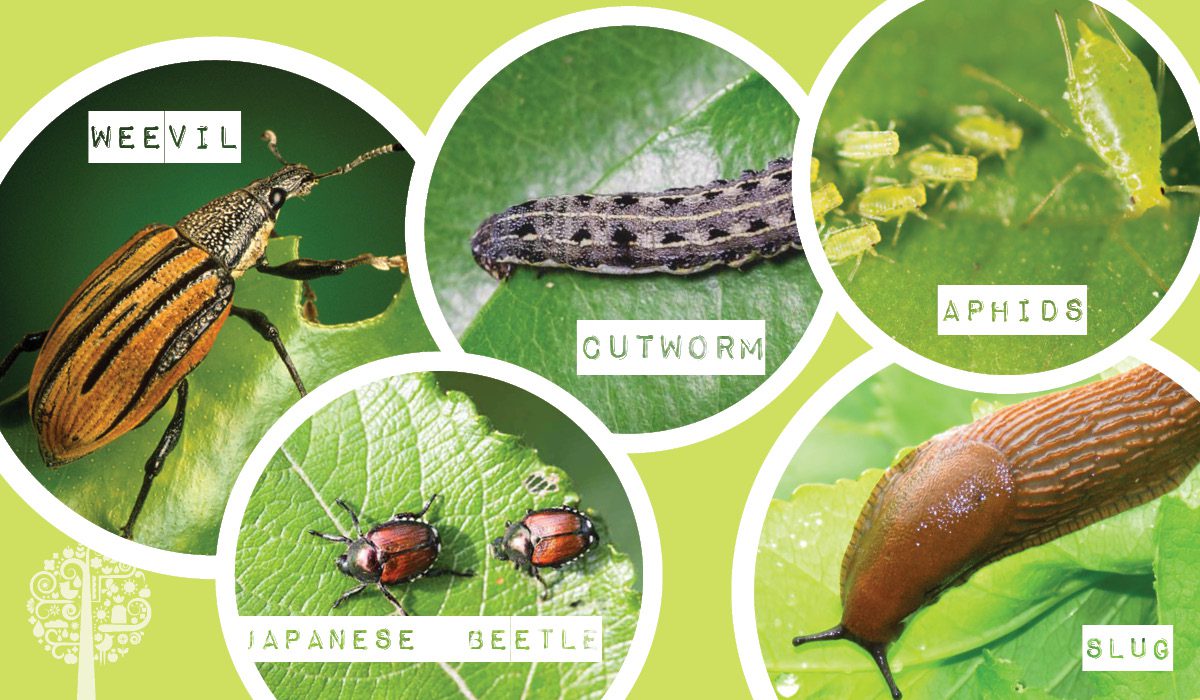Most gardeners have had to deal with bugs at one time or another, bugs that we are happy to see in the garden, and others that strike fear in us from the top of our sun hats to the tips of our green thumbs. Let’s take a look at five of the most brutal bugs for gardens. And before you look to toxic pesticides, let’s also see if there are safer and more organic ways to deal with them.

APHIDS
The Problem:
These little guys suck. Figuratively and literally. Aphids like to hang out on fruits, veggies, and flowers and suck the sap right out of them. These bugs excrete a substance called honeydew onto leaves, leading to mold growth, and they can also spread viral diseases. All that to say, you don’t want them in your garden.
The Solution:
There are a few safe and ecological things you can do to try and prevent these little buggers from destroying your crop. Use a strong water spray to wash your plants and wash off the aphids. Hot pepper and garlic repellent sprays can also work. You can also let nature do its thing by encouraging the aphids’ predators, including the likes of aphid midges, wasps, lacewings, and lady beetles.
CUTWORMS
The Problem:
Cutworms are like little, destructive lumberjacks (without the red-plaid flannel shirt). These moth larvae hide out during the day and come out at night to feast on plants. They will chow down on the first part of the plant they come into contact with, usually the stem – leaving felled seedlings in their wake.
The Solution:
Protect the seedling stems. Plastic cups and cardboard toilet paper rolls act as great protective collars. Another option is to wait a little longer before planting the seedlings – giving the stems time to grow a little thicker, and thus, more cutworm resistant.
JAPANESE BEETLES
The Problem:
There are a lot of different kinds of beetles, many of which aren’t garden-friendly. The Japanese Beetles are about a half-inch in size, are metallic blue-green with bronze wings. Their larvae are fat and white with brown heads. The adults chew through leaves and flowers while the larvae go for the roots.
The Solution:
For the adults, you can use floating row covers that restrict insects’ ability to lay eggs on the plants. Also, in the mornings (when the beetles are less active), you can shake them off the plants and into a jar of soapy water.
For the larvae, there are a couple of organic options. Apply either beneficial nematodes (microscopic worms that occur naturally in the soil) or milky spore (a bacterium). Then be patient, as both options will take a year or two to build up in the soil and be effective.
SLUGS
The Problem:
Slugs might be the most common pest on this list. We’ve all seen them – especially after a rainstorm. Like many other pests, these guys like to hang out in the shade during the day and come out at night to fill their bellies. And unlike most of our children, slugs aren’t picky at all. They will chow down on pretty much anything in your garden, leaving chew holes in the foliage as evidence of their visit.
The Solution:
Did you know that slugs are attracted to beer? Fill some empty tuna cans with beer and place them around the garden. The slugs will be drawn to them and will drown in the cans. Also, do what you can to block them from sliding their way to your plants. Sprinkling crushed shells, wood ash, or sharp sand around the stems should do the trick.
WEEVILS
The Problem:
Weevils are a type of beetle and can live for up to two years. Weevils feed on foliage and roots and are another pest that will eat almost everything – mostly veggies. Also, if they find a way into your house, they can cause just as many problems for indoor gardens as for outdoor ones.
The Solution:
Weevils are hard to find during the day. But head out to the garden at night with a flashlight, and you will spot them. Wear gloves and remove the beetles, the larvae, and eggs and throw them in soapy water. Sticky traps also work well, as does diatomaceous earth, the fossilized remains of ancient algae. The sharp shards are safe for mammals but are deadly to many soft-body insects. It’s also organic (but of course, don’t inhale it). Crop rotation, which is something you want to be doing anyway, will also help.
Please stop labelling bugs as the energy. A healthy garden ecosystem includes all types of insects and molluscs which feed other insects, birds and mammals. We need articles about encouraging more bugs not how to get rid of them. My roses were covered in aphids this year, I left them alone and within a week they were all gone with very little damage to the blooms.
Enemy not energy!